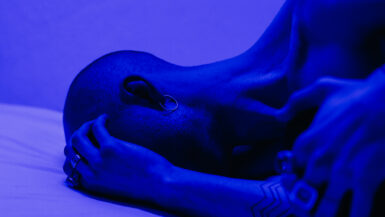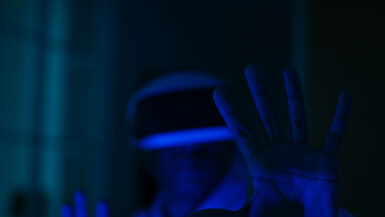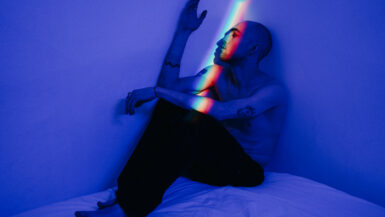In today’s fast-paced, technology-driven world, our exposure to artificial light, particularly blue light, has significantly increased. In this article, we delve into the complex relationship between blue light and its effects on our sleep patterns and overall productivity. We will explore the science behind blue light, how it interferes with our circadian rhythms, and its impact on our daily performance. Furthermore, we will discuss practical strategies to mitigate these effects and promote healthier sleep hygiene. Join us as we unravel the intricacies of blue light, equipping ourselves with the knowledge to make informed decisions for our well-being and efficiency in a digitally connected world.
Effects of Blue Light Exposure on Sleep Quality
As we delve deeper into understanding the impact of blue light on sleep quality, it is crucial to recognize how this specific wavelength of light affects our body’s internal clock or circadian rhythm. In this section, we will explore the consequences of excessive blue light exposure before bedtime, its influence on our sleep cycle, and the potential link to sleep-related disorders. Armed with this knowledge, we can make more informed decisions about our screen time and evening routines to promote healthy sleep patterns.
Disruption of Circadian Rhythm and Melatonin Production
The circadian rhythm is a vital internal process that regulates our sleep-wake cycle, adjusting to the natural light-dark cycle of our environment. Blue light exposure, particularly in the evening, can interfere with this process, affecting our body’s ability to produce melatonin – the hormone responsible for inducing sleepiness.
When we are exposed to blue light, our brains receive signals that it is still daytime, suppressing melatonin production and making it more challenging to fall asleep. Consequently, this can lead to difficulty falling asleep, frequent awakenings, and overall poorer sleep quality.
Alterations in Sleep Architecture
Sleep architecture refers to the structure and pattern of our sleep cycles, which consists of various stages, including rapid eye movement (REM) sleep and non-REM (NREM) sleep. Excessive exposure to blue light can disrupt this delicate balance, leading to inadequate restorative sleep and impacting our cognitive and physical health.
One study found that exposure to blue light before bedtime not only delayed the onset of REM sleep but also reduced its duration. REM sleep is essential for memory consolidation and emotional regulation, so disruptions in this stage can directly affect our daytime functioning.
Connection to Sleep Disorders
The effects of blue light on sleep may not be limited to sleep quality alone. There is growing evidence that exposure to blue light, especially late at night, might exacerbate sleep-related disorders such as insomnia and sleepwalking.
For instance, research has shown a potential link between blue light exposure and the prevalence of sleepwalking and night terrors in children. To learn more about this intriguing relationship, take a look at our article on The Role of Blue Light in Sleepwalking and Night Terrors.
Negative Impact on Daytime Functioning
The cumulative effects of disrupted sleep due to blue light exposure can have significant consequences on our daytime functioning. Poor sleep quality can lead to increased daytime sleepiness, difficulty concentrating, irritability, and reduced overall productivity.
As we continue to explore the complex relationship between blue light and sleep, it is essential to recognize the need for implementing healthy habits to mitigate these effects. By being mindful of our screen time and adopting practical strategies such as blue light filtering apps, we can promote better sleep quality, leading to improved overall well-being and productivity.
The Science Behind Blue Light and Melatonin
In this subsection, we will delve into the science behind blue light and its effect on melatonin production, shedding light on how our modern-day habits can interfere with our body’s natural sleep-wake cycle. By understanding the biological processes at play, we can better appreciate the importance of managing our exposure to blue light and devising practical solutions to minimize its impact on our sleep.
What is Blue Light and Where Does It Come From?
Blue light is a high-energy, short-wavelength light found in the visible light spectrum. It is naturally emitted by the sun during daytime hours and plays a critical role in regulating our circadian rhythms by signaling our brains to stay awake and alert. However, in our technology-driven world, we are also exposed to artificial sources of blue light, such as smartphones, tablets, computers, and LED lights. This prolonged and often excessive exposure can disrupt our body’s internal clock, leading to sleep disturbances and other health issues.
The Role of Melatonin in Sleep Regulation
Melatonin is a hormone produced by the pineal gland in the brain, and it plays a vital role in regulating our sleep-wake cycle. Its production is influenced by the presence or absence of light, with levels increasing in the evening as the sun sets and peaking during the night to promote sleepiness.
When we are exposed to natural sunlight during the day, our melatonin levels remain low, keeping us awake and alert. As darkness falls, the absence of light signals our brain to increase melatonin production, preparing our body for sleep. However, excessive exposure to blue light at night can interfere with this process, confusing our internal clock and disrupting our sleep patterns.
How Blue Light Affects Melatonin Production
Blue light exposure, particularly in the evening, can suppress melatonin production by stimulating a group of cells in the retina called intrinsically photosensitive retinal ganglion cells (ipRGCs). These cells are sensitive to blue light and are directly connected to the brain’s suprachiasmatic nucleus (SCN) – the master clock that regulates our circadian rhythms.
When we are exposed to blue light at night, the ipRGCs send signals to the SCN, tricking our brain into thinking it is still daytime. This, in turn, suppresses melatonin production, making it difficult for us to fall asleep and maintain a restful night’s sleep.
Armed with this knowledge, we can now appreciate the importance of managing our exposure to blue light, particularly in the hours leading up to bedtime. By taking proactive steps to reduce our exposure and implementing healthy sleep habits, we can foster better sleep quality and overall well-being.
Blue Light and Workplace Productivity
In this subsection, we will delve into the complex relationship between blue light exposure and workplace productivity. We will discuss how blue light can impact various aspects of our daily performance, from cognitive functioning to mood and mental health. By understanding the effects of blue light on our workplace efficiency, we can make informed decisions about our screen time habits and adopt strategies to minimize its negative impact on our performance.
The Double-Edged Sword of Blue Light Exposure
On the one hand, blue light exposure during daytime hours can have positive effects on our alertness, cognitive functioning, and mood. It can help regulate our circadian rhythms, keeping us awake and focused throughout the day. However, excessive exposure to blue light, particularly from artificial sources such as screens and digital devices, can have detrimental effects on our productivity and well-being.
Impaired Cognitive Functioning and Attention
One of the direct consequences of disrupted sleep due to blue light exposure is its impact on our cognitive functioning. Poor sleep quality can lead to reduced attention, difficulty concentrating, and impaired problem-solving abilities. As a result, our workplace productivity can suffer, with tasks taking longer to complete and a higher likelihood of errors occurring.
Emotional and Mental Health Consequences
Blue light exposure, especially when it disrupts our sleep, can also have significant effects on our emotional well-being and mental health. Sleep disturbances are associated with increased stress levels, irritability, and mood swings, all of which can negatively impact our interpersonal relationships and overall job satisfaction.
For a more in-depth look at the relationship between blue light exposure and mental health, check out our article on How Blue Light Affects Your Mood and Mental Health.
Reduced Energy Levels and Motivation
Feeling tired and fatigued due to poor sleep quality can have a direct impact on our energy levels and motivation throughout the day. As our ability to stay focused and alert diminishes, we may find ourselves struggling to maintain the same level of enthusiasm and drive for our work, leading to a decline in overall productivity.
Strategies for Minimizing Blue Light’s Impact on Workplace Productivity
Understanding the effects of blue light exposure on our workplace productivity is essential for making informed decisions about our daily habits and routines. By adopting strategies such as taking regular breaks from screens, utilizing blue light filtering applications, and maintaining a consistent sleep schedule, we can minimize the negative impact of blue light on our daily performance and maintain a healthy work-life balance.
In summary, recognizing the complex relationship between blue light exposure and workplace productivity is crucial for optimizing our daily performance and overall well-being. By being mindful of our screen time habits and employing practical strategies to minimize blue light’s negative effects, we can promote a healthier, more productive work environment.
How Blue Light Disrupts Circadian Rhythms
In this subsection, we will explore the mechanisms by which blue light disrupts our circadian rhythms, leading to sleep disturbances and potentially affecting our overall well-being. By understanding these processes, we can be proactive in managing our exposure to blue light and fostering healthier sleep patterns.
Blue Light’s Influence on Intrinsically Photosensitive Retinal Ganglion Cells (ipRGCs)
At the heart of the connection between blue light and circadian rhythm disruption lies a group of specialized cells in our retina known as intrinsically photosensitive retinal ganglion cells (ipRGCs). These cells are particularly sensitive to blue light and play a crucial role in regulating our body’s internal clock.
When we are exposed to blue light, the ipRGCs become activated and send signals to the suprachiasmatic nucleus (SCN), a region in the brain that serves as the master clock for our circadian rhythms. This signaling process is crucial for maintaining our natural sleep-wake cycle and keeping us alert during the day.
Confusing Signals to the Suprachiasmatic Nucleus (SCN)
Under normal circumstances, our exposure to blue light decreases as the sun sets, allowing our circadian rhythms to shift towards sleep. However, with the widespread use of digital devices and artificial lighting, our exposure to blue light often extends well into the evening.
This prolonged exposure to blue light can send mixed signals to our SCN, leading it to believe that it is still daytime. As a result, our internal clock becomes misaligned with the natural light-dark cycle, disrupting our sleep patterns and making it difficult to fall asleep or maintain restful sleep throughout the night.
Suppression of Melatonin Production
One significant consequence of blue light’s impact on our circadian rhythms is the suppression of melatonin production. Melatonin is a hormone that plays a vital role in regulating our sleep-wake cycle, with levels increasing as the evening progresses to promote sleepiness.
However, when our circadian rhythms are disrupted by blue light exposure, melatonin production is also affected. The SCN receives signals from ipRGCs that it is still daytime, leading to a suppression of melatonin release. This can result in difficulty falling asleep, frequent awakenings, and overall poorer sleep quality.
Long-term Consequences of Circadian Rhythm Disruption
The disruption of our circadian rhythms due to blue light exposure can have long-lasting effects on our health and well-being. In addition to the immediate impact on sleep quality, chronic circadian rhythm misalignment has been linked to a range of health issues, including obesity, diabetes, cardiovascular disease, and even certain types of cancer.
Therefore, it is essential to recognize the potential consequences of blue light exposure on our circadian rhythms and take steps to minimize its impact on our sleep and overall health. By being mindful of our screen time habits, adopting healthy sleep hygiene practices, and considering the use of blue light filtering applications, we can promote better sleep quality and ultimately enhance our well-being.
Blue Light Filtering Solutions for Better Sleep
As we continue to explore the complex relationship between blue light exposure and sleep, it becomes increasingly important to consider practical strategies to mitigate its effects. In this subsection, we will discuss various blue light filtering solutions that can be implemented to reduce the impact of blue light on our sleep patterns, ultimately promoting better sleep quality and overall well-being.
Blue Light Blocking Glasses: A Stylish and Functional Solution
One popular solution for reducing blue light exposure is wearing blue light blocking glasses. These specially designed eyewear products are fitted with lenses that filter out a portion of the blue light emitted by digital devices and artificial lighting. By wearing these glasses, particularly in the hours leading up to bedtime, you can minimize the suppression of melatonin production and encourage a more restful night’s sleep.
Embrace Screen-Free Activities Before Bedtime
One of the simplest and most effective ways to reduce blue light exposure is to establish a screen-free routine before bedtime. By engaging in relaxing, screen-free activities such as reading a physical book, meditating, or taking a warm bath, we can give our brains a much-needed break from the stimulating effects of blue light and prepare our bodies for a restful night’s sleep.
Blue Light Filtering Apps and Software: Harnessing Technology for Better Sleep
Recognizing the impact of blue light on sleep, several developers have created apps and software solutions that can be installed on digital devices to reduce blue light emissions. These programs typically adjust the color temperature of your device’s screen to emit warmer, less stimulating light, especially during evening hours. Examples of such applications include f.lux for computers and Night Shift for iOS devices. By utilizing these tools, we can reduce the impact of blue light on our sleep patterns while still enjoying our digital devices.
Optimizing Your Sleep Environment with Blue Light-Reducing Light Bulbs
Another strategy to minimize blue light exposure at home is to replace traditional LED light bulbs with blue light-reducing alternatives. These specialized light bulbs emit a warmer, more sleep-friendly spectrum of light, helping to reduce the impact of blue light on our circadian rhythms. By creating a more relaxing sleep environment with these lighting solutions, we can support healthy sleep patterns and enhance our overall well-being.
Establishing a Consistent Sleep Schedule: The Foundation for Better Sleep
While blue light filtering solutions can undoubtedly help mitigate the effects of blue light exposure, it is essential to recognize the importance of maintaining a consistent sleep schedule as a foundation for better sleep. By going to bed and waking up at the same time each day, we can support our body’s natural sleep-wake cycle and promote healthier, more restorative sleep.
With a wide variety of blue light filtering solutions available, we can take proactive steps to reduce the impact of blue light on our sleep patterns and overall well-being. By incorporating these strategies into our daily routines and maintaining a consistent sleep schedule, we can foster better sleep quality, ultimately leading to improved health and productivity.





Leave a reply